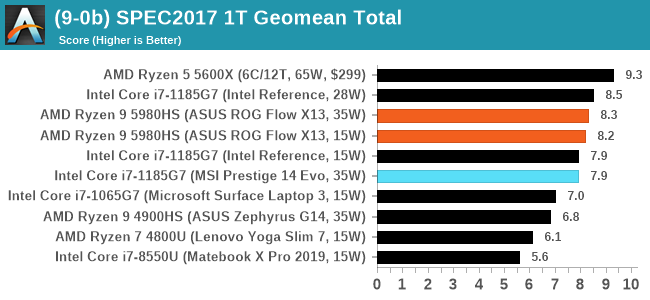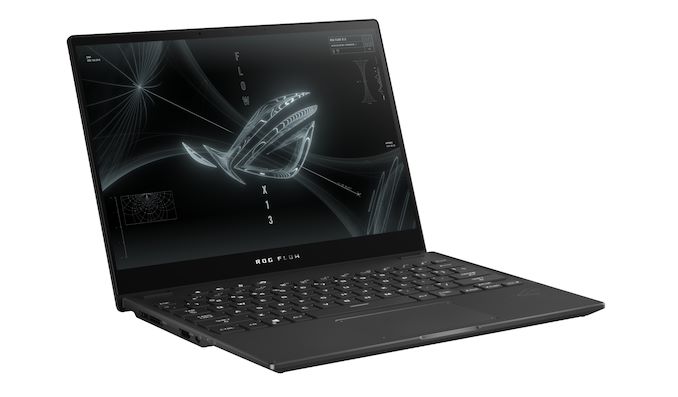AMD Ryzen 9 5980HS Cezanne Review: Ryzen 5000 Mobile Tested
by Dr. Ian Cutress on January 26, 2021 9:00 AM EST- Posted in
- CPUs
- AMD
- Vega
- Ryzen
- Zen 3
- Renoir
- Notebook
- Ryzen 9 5980HS
- Ryzen 5000 Mobile
- Cezanne
Focusing on Premium Experiences
The issue with AMD’s notebook strategy through the 2010s was that most users saw the brand as a budget implementation, with low performance and low specifications. Both AMD and its OEM partners were complicit in assisting this projection, using 1366x768 TN screens and slow mechanical hard drives. There were a number of negative feedback loops preventing a nice AMD mobile system from hitting the market, and the only key design wins were from mass corporate sales. With the launch of the first Ryzen Mobile towards the end of the decade, AMD finally had a performance product worthy of attention, and the company has had a steady improvement generation-on-generation, convincing its OEM partners to come along and take advantage of the performance uplift for their customers.
AMD’s historic lows in that 2010 decade were performance, specifications, and battery life. With Ryzen 4000 Mobile, from last generation, AMD had a product that could dispel all those assumptions, and we saw critical acclaim put upon devices like the Lenovo Slim 7 Yoga, and the ASUS Zephyrus G14. From our review of the new generation today, Ryzen 5000 Mobile, the whole strategy that AMD is playing has finally come into focus.
AMD stated that the new generation Ryzen 5000 Mobile processors were in the lab and up-and-running only two months after Ryzen 4000 Mobile launched. AMD made both sets of processors pin-compatible, allowing OEM partners to build designs that could be used for either processor family. The key here that I’ve realized is that AMD’s ultimate goal with these was to build a strong Ryzen 5000 Mobile family, and Ryzen 4000 Mobile was an option for partners to take baby steps, but the main goal was Ryzen 5000, with Zen 3. AMD’s statement of already having over 150+ system designs in the works with Ryzen 5000 Mobile, another +50% over the previous generation, along with this strategy of having a regular predictable cadence of products through re-use of different hardware elements showcases why Ryzen 5000 Mobile is important to the company. With AMD’s recent supply issues as well, we’re of the opinion that AMD has been stockpiling these Ryzen 5000 Mobile processors in order to enable a strong Q1 and Q2 launch of the platform with stock for all OEMs.
What we tested today is one of the AMD flagships for launch, the Ryzen 9 5980HS inside the ASUS ROG Flow X13. This is a sub-16mm ultraportable gaming laptop with a mid-range discrete GPU installed, an impressive 4K 16:10 Pantone certified IPS display, 32GB LPDDR4X memory and a 1 TB NVMe SSD. It also has an executive feel and design, indicating that both AMD and ASUS want to take this platform to its most premium customers. We’re leaving a full review of the laptop itself for a later date, let us focus on the performance of the processor inside.
The jump from Zen 2 to Zen 3 in the mobile space for AMD is more than just putting in the new cores. The cache adjustment from a split 4+4 MB L3 cache to a unified 16 MB L3 cache enables a better effective latency and less reliance on constantly going out to main memory – AMD is also aggressive on the L3 prefetching policies to drive performance. We can see that the single 8-core CCX has low core-to-core communication latency showcasing that enthusiast level workloads will benefit in more ways than one.
AMD is also piling on improvements to help with power, such as enabling different per-core voltage levels and a more efficient memory controller. Per-core voltage control is something that every modern CPU has to have (or at least islands of CPUs) in order to get the best battery performance. AMD is pairing this with its CPPC2 support, and users will benefit from very quick idle-to-turbo performance for immediate responsiveness.

For our benchmark suite, almost all of our benchmarks show an uplift for the new Ryzen 5000 Mobile series, some considerably so: our compile benchmark is +12%, Corona rendering is +18%, Dolphin emulation +17%, NAMD +8%, Blender +6%. To our surprise our SPEC2006 1T benchmark is +32%, accelerated considerably by the 16 MB L3 cache, but also because these CPUs also support a higher instantaneous power turbo modes than the previous generation. This enables some competitive performance numbers against Intel’s Tiger Lake platform in single thread focused tests (AMD wins on multithread quite easily).
All of these core updates, as well as design wins enabling better hardware under the hood, put AMD’s Ryzen 5000 Mobile series in good stead to power a generation of machines especially as more and more of us work from home. When Intel was in a period of high demand through 2018 and 2019, Intel focused on premium solutions to make the most revenue - Intel’s financials last week showed that the company was selling more and more education-focused low-end notebooks and Chromebooks, now that demand had reduced. We can apply something similar to AMD's current situtation - AMD’s silicon is in high demand for 2021, and so AMD’s target this year would appear to be more mid-range, premium commercial, and enthusiast machines. To reaffirm this, AMD has also promised that we will see notebooks this year paired with the most powerful mobile graphics cards, enabling high-performance gamers to move to AMD. No doubt we will have a number pass through our hands through the year, especially as they hit the shelves starting February.












218 Comments
View All Comments
Meteor2 - Thursday, February 4, 2021 - link
Web JavaScript benchmarks really don't count for much. They certainly don't reflect the user experience of the web.DigitalFreak - Tuesday, January 26, 2021 - link
It's all about the money, and I'm pretty sure Intel is handing out more marketing funds and rebates than AMD. Most people don't care if they have Intel or AMD in their laptop.msroadkill612 - Tuesday, January 26, 2021 - link
Yes its about money and no Intels strategies dont seem to be hiding reality so well these days - OEMs are deserting their designs in droves.There is a deal breaking cost & power saving at the mainstream mobile sweet spot, where the APU delivers competent modern graphics w/o need of a DGPU.
Intel can only match amd graphics by adding a dgpu.
Deicidium369 - Wednesday, January 27, 2021 - link
"OEMs are deserting their designs in droves." Really? So now only 10:1 vs AMD designs?Deicidium369 - Wednesday, January 27, 2021 - link
Providing designs to OEMs and supplying most of the parts for a laptop - making it super easy for them to come to market with an Intel design... That's called smart business.Spunjji - Thursday, January 28, 2021 - link
That's not the same thing as marketing funds and rebates, which Intel also do - they even do it at the reseller level.So there's "smart business", then there's "buying marketshare", and then there's "outright bribery". Intel got fined for doing the last one, so now they mostly only do the first two - although it's a toss-up as to whether you think their contra-revenue scheme counted as option 2 or 3.
theqnology - Wednesday, January 27, 2021 - link
It's easy to compare them (M1 vs x86) on some metrics, but I think it is more nuanced than that. Do note that M1 is at 5nm, with size at around 120.5mm^2. The AMD parts are at 180mm^2 at 7nm. The M1 has 16 billion transistors versus 10.7 billion transistors for the Zen3 APUs. That is 49.5% more transistors in favor of M1.I think a huge part of the reason M1 performs so well in many benchmarks, are that it can target specific workloads, and offload it to specific hardware cores for specific accelerated performance at lower power consumption. It becomes easy for Apple to achieve such, I think, because this is all transparent from the application developers, as they control the entire hardware AND software stack, much like consoles performing at high-end GPU levels despite having less powerful GPU cores.
This is not a cost-effective approach, although not impossible for AMD and Intel. Also part of the reason why I think if M1 were put into cloud servers, it would not be cost-effective. There will be so much dedicated hardware accelerated cores that will not be put to use when M1 is deployed in the cloud.
That said, Apple M1 is a great feat. Hopefully, AMD can also achieve a similar feat (high efficiency accelerated processing) using their Infinity Fabric and glue, allowing them to continue focusing on their Zen cores while also uplifting ancillary workload performance. The big impediment here, would be the OS support, unless it becomes a standard.
GeoffreyA - Sunday, January 31, 2021 - link
An interesting thought and one I'd like to see reviewers looking into. Also, if it were possible to get Windows ARM running on the M1, that would be an insightful experiment, removing Apple's software layers out of the picture.Deicidium369 - Wednesday, January 27, 2021 - link
Intel is in premium laptops because they make it easy for the OEMs to make good designs - not only the "blueprints" but also high efficiency parts other than just the CPU. So an OEM has little to no R&D expense, and can roll out a great laptop.AMD should do the same - it's good business and would negate the reticence of the OEMs to invest in a smaller segment - not like this would have AMD selling more than Intel - but would improve their market presence in laptops significantly.
Spunjji - Thursday, January 28, 2021 - link
"AMD should do the same"I suspect they will once they have the funds to do so. You can't just bully your way into a market by copying the precise strategies of a company that's several times larger than you.